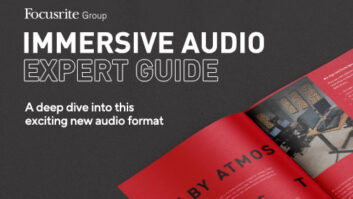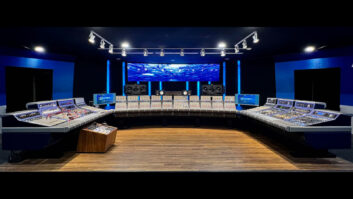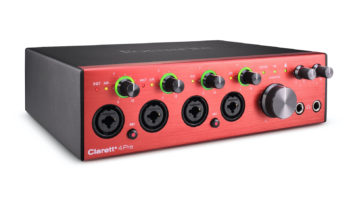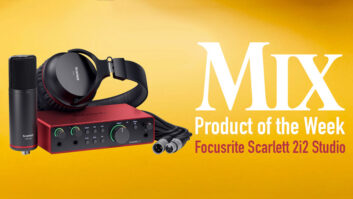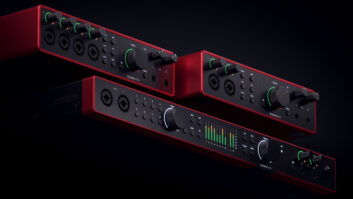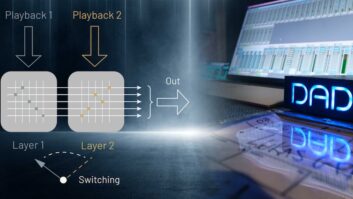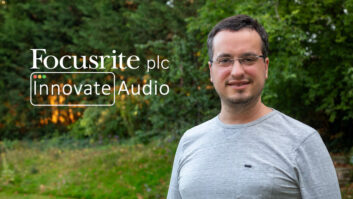
Recently, Focusrite has offered a product line aimed at the homestudio. However, as the $1,995 ISA428 can attest to, the company hasnot forgotten its high-end roots. This“four-preamps-in-a-box” was a pleasure to use, and lives upto the expectations of classic Focusrite gear.
The front-panel controls on the ISA428’s transformer-coupled preampsare placed far enough apart so that even the small ones — such asphantom power, phase and insert buttons — are easy to adjust.Below the large analog meters (with peak LEDs) is the knob to adjustgain in 10dB increments, a gain trim pot with a continuously variable±20dB range, and a 16Hz to 420Hz sweep, -18dB/octave HP filtercontrol. Each preamp section has push buttons to select the maximumattainable gain (+30/+60 dB); mic, line or ¼-inch instrument inputsource; variable- input impedance; and HP filter in/out. All buttonsexcept the input and impedance controls are backlit.
The unit’s right side handles the A/D converterfunctions, with an ADC Soft Limiter in/out toggle, clock-select button(44.1/48/88.2/96/176.4/192 kHz), 16/20/24-bit resolution switch,external word/ superclock select, digital lock light, and thedual-mode, six-segment LED meters. The meter’s dual functionality isdetermined by the optional ADC card: If the card is not fitted, meters5 through 8 are inactive and 1 through 4 read the output of each micpreamp, with the top LED representing 0 dBfs (+22 dBu). With the cardinstalled, all meters are active and read the preconverter signal pathafter the soft limiter.

The back panel has the XLR I/Os for each mic preamp and fouradditional ADC inputs. Although there are only four mic preamps,installing the optional ADC card adds four additional digitalline inputs; a nice add to the value of the ADC option, to say theleast. In addition, each channel has three balanced TRS connectors,each carrying a line input, insert send and insert return.
The $695 ADC card has Lightpipe I/O, Word Clock I/O and two 9-pinconnectors handling AES-only or combination AES and S/PDIF —eight channels of audio, a real plus. The AES-only connector can beconfigured as either single-wire or double-wire forbackward-compatibility with older equipment. The other connector can beswitched between AES or S/PDIF signals and needs only the righttermination to correctly interface with its digital partner. Onelimitation of the card occurs when interfacing with Pro Tools|HD: Withonly four inputs above 96 kHz, you can’t input the ADC’s fouradditional line inputs into HD.
IN THE STUDIO
I used the 428 on a variety of instruments with several differentmics. In a word, the 428 sounds fantastic. It’s clean, clear, versatileand completely pro.
One of the most revealing tests for a mic preamp is using it with aribbon mic; in this case, an AEA R84 on a number of sources. Here, thevariable-impedance control became a valuable tone-shaping tool. I firstused the mic on a Martin acoustic guitar and could control the soniccharacteristics easily with the impedance controls. (For more on howthe variable impedance control relates to ribbon mics, read the onlineextra at www.mixonline.com.) Ribbons tend to be low-outputtransducers, requiring a lot of input gain. I could get plenty of cleanlevel out of the 428: a whopping 80 dB of gain. There was an expectedbit of noise at the very top of the throw, but it was not a factorbecause I never needed that much boosting.
The optional digital section is especially sweet. I used itexclusively to get into Pro Tools|HD because it sounded so good. I usedthe 428 at 48 kHz and 96 kHz, recording acoustic instruments includingdobro, upright bass, banjo, guitar and percussion. It was stellar inevery application: I quickly appreciated how easily I could get a greatsound. In one case, I recorded a Danelectro baritone guitar with greatresults. It was as simple as plugging it in and setting levels. Thesound was crystalline, full-bodied and needed no EQ.
The 428’s metering is perfect for digital recording. I found myselftrusting it more and more with use. It’s a confidence-builder thatfrees your mind for more creative use when you don’t have to worryabout checking three meters in your signal path.
The ISA428 is not simply four preamps in one box, but four preampsthat sound so good. The box is pro inside and out with Lundahl 1538input transformers, as originally spec’d by early Focusrite designs.The fit and finish are what you’d expect from Focusrite: Every knob,button, connector is top-notch. And it’s a tweaker’s delight, withextra touches such as variable-input impedances, dual-metering, HPfilters and the optional digital back end (with added inputs).
All said, a couple of things could be better. The“low/ISA110/med/high” variable- impedance control settingsare confusing. Competing boxes such as Groove Tube’s VIPRE indicatevalues in ohms, which is easier to set in the heat of the session.However, the well-written ISA428 manual has a great tutorial onvariable impedance to clear up any user questions. One minor point: Onthe rear panel, if inputs 1/2 were on top and 3/4 on the bottom, thenhookups would be much more intuitive, especially for those blind gropesin the dark that are all too common in the working studio.
Aside from a few minor gripes, this preamp gets straight A’s in alldepartments. If you’re looking for a rock-solid, great-sounding,well-designed set of preamps — and who isn’t? — then theISA428 should be on your must-see list.
Focusrite, dist by Digidesign, 650/731-6300, www.focusrite.com.

Click here for an in-depth look at what actuallygoes on with the variable impedance control in relation to ribbons, byWes Dooley.
